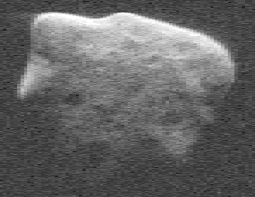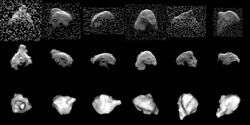(53319) 1999 JM8
(53319) 1999 JM8 is an asteroid, slow rotator and tumbler, classified as a near-Earth object and potentially hazardous asteroid (PHA) of the Apollo group, approximately 7 kilometers (4 miles) in diameter, making it the largest PHA known to exist.[12] The body's shape is bizarre, and is vaguely reminiscent of a "roast chicken". It was discovered on 13 May 1999, by astronomers of the Lincoln Near-Earth Asteroid Research at the Lincoln Laboratory's Experimental Test Site near Socorro, New Mexico.[2]
 | |
| Discovery [1][2] | |
|---|---|
| Discovered by | LINEAR |
| Discovery site | Lincoln Lab's ETS |
| Discovery date | 13 May 1999 |
| Designations | |
| (53319) 1999 JM8 | |
| 1999 JM8 · 1990 HD1 | |
| NEO · PHA · Apollo [1][2] Mars-crosser | |
| Orbital characteristics [1] | |
| Epoch 4 September 2017 (JD 2458000.5) | |
| Uncertainty parameter 0 | |
| Observation arc | 27.57 yr (10,070 days) |
| Aphelion | 4.4740 AU |
| Perihelion | 0.9783 AU |
| 2.7261 AU | |
| Eccentricity | 0.6411 |
| 4.50 yr (1,644 days) | |
| 19.009° | |
| 0° 13m 8.4s / day | |
| Inclination | 13.829° |
| 133.65° | |
| 166.77° | |
| Earth MOID | 0.0235 AU · 9.2 LD |
| Jupiter MOID | 0.8477 AU |
| Physical characteristics | |
| Dimensions | 5 km[3] 5.4±1.2 km[4] 6.4 km[5] 7 km[6][7] |
| 136±2 h[8] | |
| 0.02±0.01[4] 0.03 (derived)[9] | |
| SMASS = X: [1] · C [10] X (Tholen)[9] | |
| 15.00[10] · 15.14±0.38[11] · 15.2[1][9] · 16.5[4] | |
Orbit and classification
1999 JM8 orbits the Sun at a distance of 1.0–4.5 AU once every 4 years and 6 months (1,644 days; semi-major axis of 2.73 AU). Its orbit has an eccentricity of 0.64 and an inclination of 14° with respect to the ecliptic.[1] This makes it also a Mars-crossing asteroid.
The body's observation arc begins with its first identification as 1990 HD1 at Palomar Observatory in April 1990, more than 9 years prior to its official discovery observation at Socorro.[2]
Close approaches
1999 JM8 has an Earth minimum orbital intersection distance of 0.0235 AU (3,520,000 km) which translates into 9.2 lunar distances.[1] It passed closer than 0.20 AU to the Earth five times in the last century (0.033 AU in 1990), but its next closest approach in the 21st century will be in 2075 at 0.256 AU 0.256 au (38,300,000 km; 23,800,000 mi) and in August 2137 at 0.0764 au (11,430,000 km; 7,100,000 mi).[1] For comparison, the planet Venus' closest approach to Earth is about 40 million km (25 million mi).
Physical characteristics

In the SMASS and Tholen classification, 1999 JM8 is an X-type asteroid.[1][9] It has also been characterized as a carbonaceous C-type asteroid, which seems more likely due to its exceptionally low albedo (see below).[10]
Rotation period
Radar imaging by Goldstone and Arecibo observatories revealed that 1999 JM8 has an unusually slow and possibly chaotic rotation period, similar to that of asteroid 4179 Toutatis.[9][5]
In July 1999, a rotational lightcurve of 1999 JM8 was obtained from photometric observations. It gave a period of 136±2 hours with a brightness amplitude of 0.7 magnitude (U=2), and suggested that the body is in a non-principal axis rotation, commonly known as tumbling.[8]
Numbering and naming
This minor planet was numbered by the Minor Planet Center on 16 February 2003.[13] As of 2018, it has not been named.[2]
References
- "JPL Small-Body Database Browser: 53319 (1999 JM8)" (2017-11-21 last obs.). Jet Propulsion Laboratory. Retrieved 23 November 2017.
- "53319 (1999 JM8)". Minor Planet Center. Retrieved 23 November 2017.
- Benner, L. A. M.; Nolan, M. C.; Margot, J.-L.; Giorgini, J. D.; Hudson, R. S.; Jurgens, R. F.; et al. (May 2001). "Recent Radar Observations of Four Near-Earth Asteroids". American Astronomical Society. 33: 918. Bibcode:2001AAS...198.8907B. Retrieved 23 November 2017.
- Reddy, Vishnu; Gaffey, Michael J.; Abell, Paul A.; Hardersen, Paul S. (May 2012). "Constraining albedo, diameter and composition of near-Earth asteroids via near-infrared spectroscopy". Icarus. 219 (1): 382–392. Bibcode:2012Icar..219..382R. doi:10.1016/j.icarus.2012.03.005. Retrieved 23 November 2017.
- Brozovic, M.; Benner, L. A. M.; Nolan, M. C.; Ostro, S. J.; Margot, J. L.; Giorgini, J. D.; et al. (May 2012). "Shape Modeling of Near-Earth Asteroid (53319) 1999 JM8 from Goldstone and Arecibo Radar Images". Asteroids. Bibcode:2012LPICo1667.6183B. Retrieved 23 November 2017.
- Benner, L. A. M.; Ostro, S. J.; Nolan, M. C.; Margot, J.-L.; Giorgini, J. D.; Hudson, R. S.; et al. (November 2001). "Radar Observations of Asteroid 1999 JM8". American Astronomical Society. 33: 1153. Bibcode:2001DPS....33.6106B. Retrieved 23 November 2017.
- Benner, Lance A. M.; Ostro, Steven J.; Nolan, Michael C.; Margot, Jean-Luc; Giorgini, Jon D.; Hudson, R. Scott; et al. (June 2002). "Radar observations of asteroid 1999 JM8". Meteoritics and Planetary Science: 779–792. Bibcode:2002M&PS...37..779B. doi:10.1111/j.1945-5100.2002.tb00855.x. Retrieved 23 November 2017.
- Pravec, P.; Harris, A. W.; Scheirich, P.; Kusnirák, P.; Sarounová, L.; Hergenrother, C. W.; et al. (January 2005). "Tumbling asteroids". Icarus. 173 (1): 108–131. Bibcode:2005Icar..173..108P. doi:10.1016/j.icarus.2004.07.021. Retrieved 23 November 2017.
- "LCDB Data for (53319)". Asteroid Lightcurve Database (LCDB). Retrieved 23 November 2017.
- Carry, B.; Solano, E.; Eggl, S.; DeMeo, F. E. (April 2016). "Spectral properties of near-Earth and Mars-crossing asteroids using Sloan photometry". Icarus. 268: 340–354. arXiv:1601.02087. Bibcode:2016Icar..268..340C. doi:10.1016/j.icarus.2015.12.047. Retrieved 23 November 2017.
- Veres, Peter; Jedicke, Robert; Fitzsimmons, Alan; Denneau, Larry; Granvik, Mikael; Bolin, Bryce; et al. (November 2015). "Absolute magnitudes and slope parameters for 250,000 asteroids observed by Pan-STARRS PS1 - Preliminary results". Icarus. 261: 34–47. arXiv:1506.00762. Bibcode:2015Icar..261...34V. doi:10.1016/j.icarus.2015.08.007. Retrieved 23 November 2017.
- https://echo.jpl.nasa.gov/asteroids/Phaethon/Phaethon_planning.2017.html
- "MPC/MPO/MPS Archive". Minor Planet Center. Retrieved 24 February 2018.
External links
| Wikimedia Commons has media related to (53319) 1999 JM8. |
- Asteroid Lightcurve Database (LCDB), query form (info)
- Asteroids and comets rotation curves, CdR – Observatoire de Genève, Raoul Behrend
- Discovery Circumstances: Numbered Minor Planets (50001)-(55000) – Minor Planet Center
- (53319) 1999 JM8 at AstDyS-2, Asteroids—Dynamic Site
- (53319) 1999 JM8 at the JPL Small-Body Database
